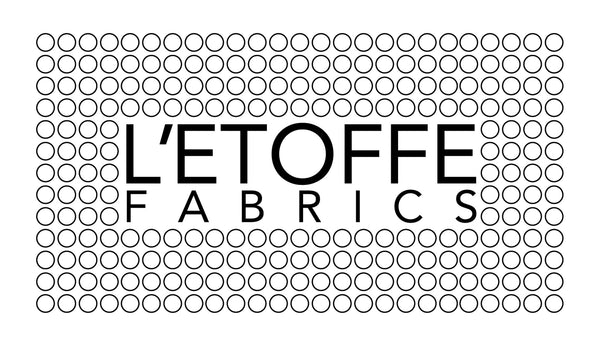
Fabric Care for Home Sewers
Share
I often get questions about how to care for fabric purchases. Unfortunately deadstock fabric does not come with prescribed fabric care instructions. Most designers will just label clothing, "dry clean only" to avoid any responsibility but really a hand wash cool, hang dry is my go to for almost everything. I don't own a dryer. However when we make our own clothes the practice of fabric care is part of our daily life. We work hard to make something and want to take good care of it. So below is a basic outline of my thoughts and some best practices for how to incorporate fabric care into our lifestyle and resources. In my mind the question isn’t about how to wash but more about how flexible you are to fiber changes, your lifestyle, and resources. Making your own clothes has so many benefits especially when we consider the cost and environmental impact of dry cleaning on the environment so thank you!
The following is based on my experience there are no hard facts here this is why I recommend testing first.
L’Etoffe Fabrics is not responsible for fabric care after it has been purchased.
Sew and Design a Fabric Care Program Around Your Lifestyle
How much time and energy are you willing to spend caring for your clothes. I like to think in terms of percentages. For example, 75% all cotton and linen (super easy care), 5% dry clean, 20% hand wash, etc. Fiber types can dictate the time and energy needed. The space where you live can also guide your choices. Do you share a laundry room and can you line dry. Work with what you got and tailor your fabric choices around your lifestyle. This will make your sewing journey more rewarding.
General Best Practices
First Give Your Fabric a Stress Test
Really a stress test for me is just to see if there are any major changes to the fabric after it gets wet and can I live with them. For example, does the wool felt up or does the application of water fundamentally change the fabric and can I live with them. Just take a 4" x 4” square and soak in a jar of scalding hot water for 30 minutes, you can throw in the dryer with a load if you like as well. Measure for shrinkage. Keep in mind a stress test is once, so this does not mean that over time the fabric will look exactly the same it is just going to show you what happens when the fabric gets wet.
By Default: delicate cycle, cool water, hang dry
Linen needs some moisture to stay malleable, if you hang dry don't leave out in the sun too long or don’t leave in the dryer to get “over dried.”
Yes, you can hand wash/hang dry most silks like chiffon and crepe de chine. Silk prints are great for handwashing because they are not a solid color. Silk solids can sometimes have a “washed” color over time - and many of us like this and some of us don’t. Washed silks is what Dries Van Noten was known for you may or may not like this "look." You may want to dry clean silk, especially 4 ply. People all around the world have been wearing silk for 1000's of years, they don’t dry clean. The decision is up to you.
Spandex will break down under heat so no hot dryer, no hot dryer on anything with elastine or stretchy fabrics/elastic.
Standard rayon (made from trees) is weak when wet, does not like friction. Rayon knits should not go in a washer or dryer if longevity is important. If you pop a rayon jersey in the washer and dryer once and it looks great, this does not mean it will look “great” after 10 more washes. However, there are many new sources and treatments of rayon that are stronger and easier to care for like tencel. Textile science is always improving the care and sources of rayon. By default I will delicate cycle with other delicate items (or hand wash), hang dry or cool dry in dryer and finish on the line.
Going Forward…. ask yourself a couple of questions:
- Can you accept a slight change in the property of the fabric once washed/prewashed to avoid having to dry clean? This is the big question - just let go, be flexible and willing to accept change and if not dry clean - hopefully you have a “green cleaner” in your area.
- Reflect on your lifestyle. Do you have space to hang dry or do you need to use the dryer? Is someone in your household going to accidentally put your silk dress in with the dish towels? What kind of dryer do you own or is at your local laundromat.
- Will you consider handwashing? I have white BPA free paing buckets that I use to hand wash, they are portable so easy to move around. I like to wash outside so I can use the rinse water to wash the patio or driveway.
- Do you share a laundry room in an apartment complex or do you own your own. Are they top load? Are the washers at the laundromat front load or more gentle than the ones in your apartment complex?
- If you own your own....how old is your washer? The kind of washer you have can really make a difference not only in energy and water consumption but also in the care of your garments. I recommend going to the library and checking out the latest Consumer Reports magazine to read up on the latest washers and dryers. It may be time to update your washer, it’s a good investment. I don’t own a dryer for environmental reasons but I also live in a desert.
Do I need to Dry Clean this?
Technically there really aren’t that many types of fabric that absolutely have to be dry cleaned. I like to think of all the beautiful garments all around the world that were created before modern dry cleaning was invented and how they were washed or not. When we buy something in the store it usually says - ”dry clean only” because the fabric wasn’t preshrunk/washed and the manufacturer doesn’t want the cost and to be responsible for any complaints or returns to the store from any changes to the fabric once washed. There are some fabrics that need to be dry cleaned like pleated silk (or other pleated fabrics with no synthetic content) because the pleats will fall when wet or other special fabrics like those with a heavy lamé - lurex content - fancy special fabric they can get theoretically get wet if you need to spot clean but to keep the quality and condition it’s best to dry clean. Raw silk likes to be dry cleaned and some other textured silks. Maybe silk velvet will be easier to just dry clean but you can hand wash this too, especially if you like the “washed silk” look. Now if you made a big heavy wool coat or a tailored jacket you may just want to dry clean that too (even if you preshrunk all the fabric and interfacing) because it’s a lot of work to press and if you only dry clean these garments once a season that isn’t so bad but you CAN wash them if you want. This goes back to being flexible to changes. If you are super particular and want the fabric to look exactly the same in every way then just dry clean.
I hope some of this helps to frame how to approach fabric care, remember considering your lifestyle and resources will make this venture so much simpler.
